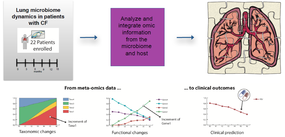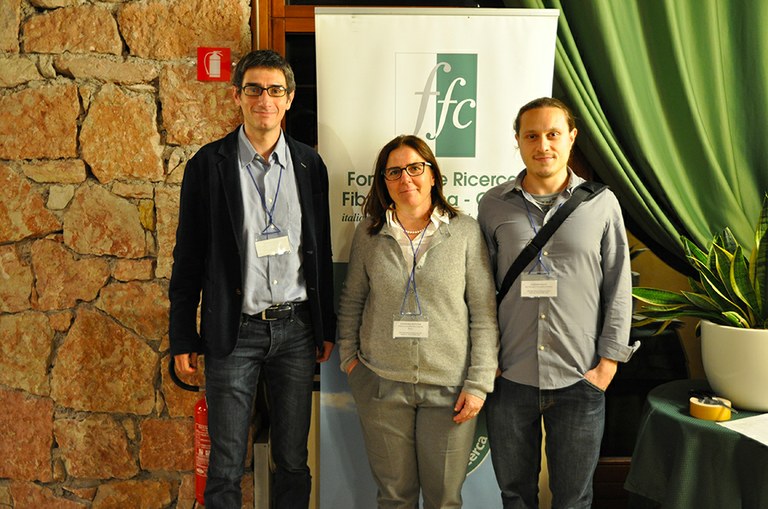Health: Cystic fibrosis, paving the way towards new therapies
15/10/2020
 Increasingly effective, tailored therapies to treat cystic fibrosis. This is the aim of the researchcoordinated by ENEA and funded by the Cystic Fibrosis Research Foundation, whose outcomes were published in the ‘open access’ journal Microorganisms-MDPI (https://www.mdpi.com/2076-2607/8/7/1003/htm).
Increasingly effective, tailored therapies to treat cystic fibrosis. This is the aim of the researchcoordinated by ENEA and funded by the Cystic Fibrosis Research Foundation, whose outcomes were published in the ‘open access’ journal Microorganisms-MDPI (https://www.mdpi.com/2076-2607/8/7/1003/htm).
The study was conducted on 22 patients [1] aged between 11 and 55, suffering from moderate or severe forms of cystic fibrosis, selected among three Italian hospitals: Bambino Gesù in Rome, Meyer in Florence and Gaslini in Genoa.
"During the 15 month investigation we collected 79 sputum samples from which we extracted DNA and subjected it to massive sequencing, that is of the whole genoma collected from all the microorganisms present, with the aim of determining the composition of the microbiome, the genetic makeup of the microbial community present in each sample. This allowed us to obtain a high-resolution view of the evolution of the microbiome for each patient, putting in relation the clinical status, the microbial genetic repertoire and the resistome, i.e. the set of antibiotic resistance genes ", ENEA biologist Annamaria Bevivino, research coordinator, explained.
The survey showed that the sputum microbiome of patients is highly specific. Each patient showed distinct lung microbial communities and there is less variation within the same individual at different times (even during inflammation or antibiotic treatment) than among individuals in the same period. This demonstrates, on the one hand, a certain degree of stability over time of the microbial community of an individual and, on the other hand, a high heterogeneity among patients, save for a range of bacterial genes, such as antibiotic resistance genes, which were common to the entire sample.
 "Identifying the microbial genetic makeup associated with cystic fibrosis could provide physicians with new knowledge, ranging from biomarkers to identify the progression of the disease to new 'targets' for antibiotic therapy. This would allow to identify therapeutic interventions and antibiotic therapies based on the composition of the lung microbiome and 'abundance' of antibiotic resistance genes. Our objective, therefore, is to improve the management of chronic infection through increasingly tailored clinical care and treatment" Bevivino pointed out.
"Identifying the microbial genetic makeup associated with cystic fibrosis could provide physicians with new knowledge, ranging from biomarkers to identify the progression of the disease to new 'targets' for antibiotic therapy. This would allow to identify therapeutic interventions and antibiotic therapies based on the composition of the lung microbiome and 'abundance' of antibiotic resistance genes. Our objective, therefore, is to improve the management of chronic infection through increasingly tailored clinical care and treatment" Bevivino pointed out.
The microbe community present in the lung of the individual affected by cystic fibrosis is, in fact, a sort of "personal ecological niche" to be studied over time in different stages of the disease and conducting genomic investigations to analyze the genes present in the complex bacterial community, possibly useful to antibacterial choices. “As of today, neither this study nor others have yet provided us with indications for orienting these choices more appropriately than those based on colture tests. Unlike other investigations conducted so far, a particular bacterium, Rothia mucilaginosa, was found in abundance in our samples. This may suggest a potential involvement of this microorganism in the dynamics and pathogenicity of the cystic fibrosis microbiome, which deserves further study ”, the ENEA researcher said.
This research continues the studies on the lung microbiome of patients with cystic fibrosis conducted by ENEA and the Cystic Fibrosis Foundation, since only an in-depth understanding of the host-microbe and microbe-microbe interactions (which mediate the microbiome assembly) and the complex relationships among respiratory microbiome, state of the disease and response to antibiotic treatment will make it possible to prevent, diagnose and treat the disease with precision and tailored therapeutic interventions ”, Bevivino concluded.

For more information please contact:
- Annamaria Bevivino - ENEA, Laboratory Sustinability, Quality and Safety of Agrifood Production - annamaria.bevivino@enea.it
- Graziella Borgo - Fondazione per la Ricerca sulla Fibrosi Cistica - graziella.borgo@fibrosicisticaricerca.it
Press office:
- ENEA, Roberto De Ritis: ufficiostampa@enea.it
- Fondazione Ricerca Fibrosi Cistica, Patrizia Adami: ufficiostampaclab@gmail.com – 348 3820355
Paganin P, Fiscarelli EV, Tuccio V, Chiancianesi M, Bacci G, et al. (2015) Changes in Cystic Fibrosis Airway Microbial Community Associated with a Severe Decline in Lung Function. PLOS ONE 10(4): e0124348. https://doi.org/10.1371/journal.pone.0124348
Bacci G, Paganin P, Lopez L, Vanni C, Dalmastri C, et al. (2016) Pyrosequencing Unveils Cystic Fibrosis Lung Microbiome Differences Associated with a Severe Lung Function Decline. PLOS ONE 11(6): e0156807. https://doi.org/10.1371/journal.pone.0156807
Bacci, G.; Mengoni, A.; Fiscarelli, E.; Segata, N.; Taccetti, G.; Dolce, D.; Paganin, P.; Morelli, P.; Tuccio, V.; De Alessandri, A.; Lucidi, V.; Bevivino, A. A Different Microbiome Gene Repertoire in the Airways of Cystic Fibrosis Patients with Severe Lung Disease. Int. J. Mol. Sci. 2017, 18, 1654. doi: 10.3390/ijms18081654
Bevivino, A.; Bacci, G.; Drevinek, P.; Nelson, M.T; Hoffman, L.; Mengoni, A. Deciphering the Ecology of Cystic Fibrosis Bacterial Communities: Towards Systems-Level Integration. Trends Mol Med ; 25(12): 1110-1122, 2019 12.
https://doi.org/10.1016/j.molmed.2019.07.008
[1] Sample selection criteria: a diagnosis of cystic fibrosis, that is a sweat test showing a chlorine concentration> 60 mmol / L (millimoles of a liter); two known mutations in the CFTR gene which caused pancreatic insufficiency; an age between 11 and 55; Chronic Pseudomonas aeruginosa infection; (cystic fibrosis is a typical condition in which this bacterium grows in lungs, ultimately causing infection and inflammation); evaluation of the "Maximum Expiratory Volume in the 1st second" (FEV1 - Forced expiratory volume in the 1st second) which indicates the volume of air exhaled during the first second of a forced maximal expiration and the patency of large airways.
Patients were selected in hospitals which treat both pediatric and adult patients. Adult patients are pediatric patients who continue to be followed by pediatric physicians. Recently, only in hospitals that also serve as regional centers for the treatment of cystic fibrosis, ad hoc departments for adults are being set up.
